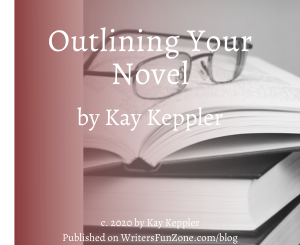Write Your Novel: Settings — Make Them Do More
Welcome to the next installment of craft posts by monthly guest columnist, Kay Keppler. Today she’ll share about setting and how to make them work for your story. You can contact Kay through the Writer’s Fun Zone or at kaykeppler@yahoo.com to ask questions, suggest topics, or tell her she’s off her rocker. (She let me say that!)
***
I can see it now—you and your Aunt Myrtle at Thanksgiving. “What’s your book about, dear?” she’ll say over turkey and gravy.
And you oblige her by saying, “Well, my heroine—that’s Artemisia Bullwinkle—finds a body in the pantry and figures out that the heir and her true love—that’s Froggie Muckbottom—did it. She sends him to the Big House, where he catches chilblains and she knits him woolen booties. And it all happens in Regency England.”
And then your Aunt Myrtle says, “That’s nice, dear,” and reaches for the cranberry sauce.
What did you just do in that short synopsis? You’ve described your characters, something of their character path, the conflict, plot, and setting. Not bad for that quiet moment after your Uncle Al threatens to eat over at the tavern if you all can’t keep it down so he can watch the football game.
In that story synopsis, everything changes—everything except Regency England, your setting. But don’t let that setting just lie there comatose like Grandpa after two pieces of pie. Your setting can work harder. Use it to advance plot and enhance tension.
Setting that Advances Plot
Without moving your characters to a different city, you want your setting to change in a way that forces—or gives your characters a reason—to take action. To do that, you could present your setting in a new way or use it to emphasize a problem. Or you could emphasize aspects of your setting that had not been realized before.
For example, let’s say that your story is set in a mountain village, which is initially described as protected and peaceful. But somebody could see it as isolated and trusting—the perfect place for a drug operation. (The setting is seen in a new way, and your hero has to….)
Then a mountain avalanche sweeps over the young girl, and she needs to be transported to a hospital, which is impossible because the roads are cut off. (The setting emphasizes a problem, and your heroine has to….)
Finally, gold was discovered in the mountains, and your drug kingpin turns to legitimate work to make his fortune. (Unrealized aspects of the setting are emphasized, and her hero must….)
Okay it’s a lousy plot idea, but you get my point. Let’s look at a real example of how setting influenced and advanced plot.
In Gone with the Wind, Tara, the plantation, looms constantly as a motivator for action. The opening shot is one of comfort and plenty. Slaves work in the fields; Scarlett flirts with the Tarleton twins. Then all the men leave to fight. The men abandon Tara, so Scarlett does, too—she leaves for Atlanta. She returns mid-war to gain security, but the plantation is ravaged. If she wants to eat, she must work the fields herself. She raises her fist to the sky and vows, “As God is my witness, I’ll never be hungry again!”
After the war, Scarlett can’t pay the taxes on the plantation; the threat of losing it propels her into hoodwinking a rich guy to marry her. Much action ensues. (Let’s not forget that when Scarlett tries to hoodwink Rhett Butler into marrying her, she wears a dress made from curtains. Tara as Project Runway!) At the end, when Rhett leaves her, what does Scarlett say she’ll do? Go back to Tara.
Tara is Scarlett’s touchstone. When something happens to it, Scarlett takes action. This is how your setting can help drive your plot.
Setting that Enhances Tension
When your setting shifts and your character along with it, dramatic tension increases. Let’s look at Rebecca by Daphne du Maurier and adapted to film by Alfred Hitchcock.
The first sentence of the book and film is “Last night I dreamt I went to Manderley again.” We never learn this person’s name, but Manderley—the house and the book’s setting, gets center stage right from the first.
After they marry, the young, unsure “I” character comes to believe that her new husband still loves Rebecca, his first dead wife, and doesn’t love “I.” Manderley’s housekeeper—and the house itself—conspire to terrorize the new wife. The house is filled with memories of the first wife—clothing, portraits, stationery, furniture, menu plans—and the young bride comes to believe that her marriage is a failure.
She is about to commit suicide by leaping from a window when…wait for it…a storm breaks (changed setting!). “I” learns she was wrong about everything. But at the end, instead of finding happiness, the house burns to the ground.
You can increase tension for your characters and readers through setting by darkening the mood of the story; introducing new, threatening elements; creating mystery; overturning previous character expectations; or demanding immediate action.
So don’t let Grandpa eat all the pie and hog the couch! Get rid of your static settings and see how a change can increase tension and get your plot—and Grandpa—moving again. It’ll be good for everybody.
***
 Kay Keppler (www.kaykeppler.com) is an author (Zero Gravity Outcasts, Betting on Hope) and editor of fiction and nonfiction (Asylum Harbor, Pragmatic Guide to Sass) who lives in northern California. Thanks to Jack M. Bickham and his book Setting (Writer’s Digest Books) for help with this column. Contact her here or at kaykeppler@yahoo.com to ask questions, suggest topics, or if you prefer, complain.
Kay Keppler (www.kaykeppler.com) is an author (Zero Gravity Outcasts, Betting on Hope) and editor of fiction and nonfiction (Asylum Harbor, Pragmatic Guide to Sass) who lives in northern California. Thanks to Jack M. Bickham and his book Setting (Writer’s Digest Books) for help with this column. Contact her here or at kaykeppler@yahoo.com to ask questions, suggest topics, or if you prefer, complain.







